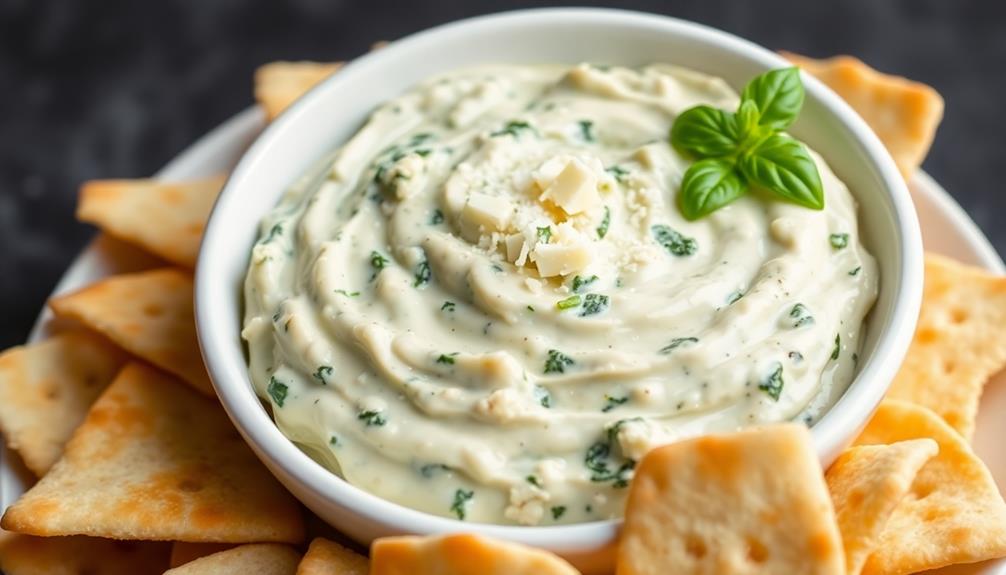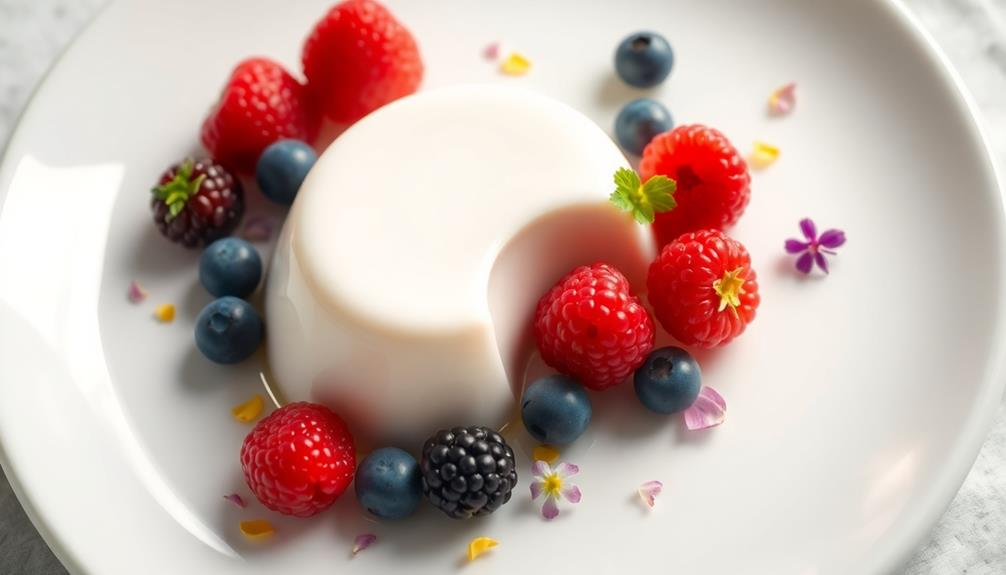The Waldorf salad is a classic American dish that's simply delightful! Originating at the iconic Waldorf-Astoria Hotel in New York City during the 1890s, this refreshing salad features a perfect blend of crisp apples, crunchy celery, and a creamy dressing that will have your taste buds dancing. You can enjoy it as a light main course or a side dish that's sure to please a crowd. With its versatility and nutritional benefits, it's no wonder the Waldorf salad has stood the test of time as a beloved staple in American cuisine. Now, let's dive deeper into the history and recipe of this timeless classic!
Key Takeaways
- Waldorf salad is a classic American dish that originated at the Waldorf-Astoria Hotel in New York City during the 1890s.
- The core ingredients of Waldorf salad are apples, celery, and mayonnaise, which contribute to its refreshing and flavorful taste.
- Waldorf salad can be enjoyed as a side dish or a light main course, making it a crowd-pleasing option for various occasions.
- Waldorf salad is versatile and can be customized with additional ingredients like walnuts, grapes, and even chicken or turkey.
- Waldorf salad is a nutritious dish that provides essential vitamins, minerals, and healthy fats from the fruits and nuts.
History
The Waldorf salad originated at the Waldorf-Astoria Hotel in New York City in the 1890s. The hotel's maitre d'hôtel, Oscar Tschirky, created the salad as a simple combination of apples, celery, and mayonnaise. It quickly became a popular dish, and the Waldorf salad gained fame for its crisp, refreshing flavors.
Over the years, the original recipe has evolved, with the addition of walnuts, grapes, and even chicken or turkey. But the core ingredients – apples, celery, and mayonnaise – remain the foundation of this classic salad.
The Waldorf salad's enduring popularity is a testament to its delicious and versatile nature. Whether served as a side dish or a main course, the salad's blend of sweet, crunchy, and creamy elements makes it a crowd-pleaser.
Today, the Waldorf salad continues to be a beloved classic, enjoyed by people around the world.
Recipe
Waldorf salad is a classic American dish that originated in the late 19th century at the Waldorf-Astoria hotel in New York City. This refreshing and flavorful salad features a delightful combination of crisp apples, crunchy celery, sweet grapes, and a creamy dressing.
The traditional Waldorf salad is a simple yet satisfying recipe that can be enjoyed as a side dish or a light main course. It's a versatile dish that can be customized to suit individual tastes, making it a crowd-pleaser at any gathering.
Ingredients:
- 3 medium crisp apples, such as Fuji or Gala, diced
- 2 cups diced celery
- 1 cup seedless green grapes, halved
- 1/2 cup chopped walnuts
- 1 cup mayonnaise
- 2 tablespoons fresh lemon juice
- 1 tablespoon granulated sugar
- 1/4 teaspoon salt
- 1/4 teaspoon ground black pepper
Instructions:
In a large bowl, combine the diced apples, celery, grapes, and walnuts.
In a separate bowl, whisk together the mayonnaise, lemon juice, sugar, salt, and pepper until well combined.
Pour the dressing over the fruit and vegetable mixture and toss gently to coat evenly.
When serving, the Waldorf salad can be chilled for a refreshing and crisp texture.
For a more indulgent version, fold in a cup of whipped cream or Greek yogurt to the dressing. Additionally, you can garnish the salad with extra walnuts or a sprinkle of chopped fresh herbs, such as parsley or chives.
Cooking Steps
Peel those crisp apples and dice them into bite-sized pieces.
Next, chop up some fresh celery and fold it all together with a creamy dollop of mayonnaise and a squeeze of tangy lemon juice.
Finally, sprinkle on a handful of crunchy, crushed walnuts to add the perfect finishing touch.
Be sure to chill the salad before serving for a refreshing and flavorful dish.
Step 1. Peel and Dice Apples
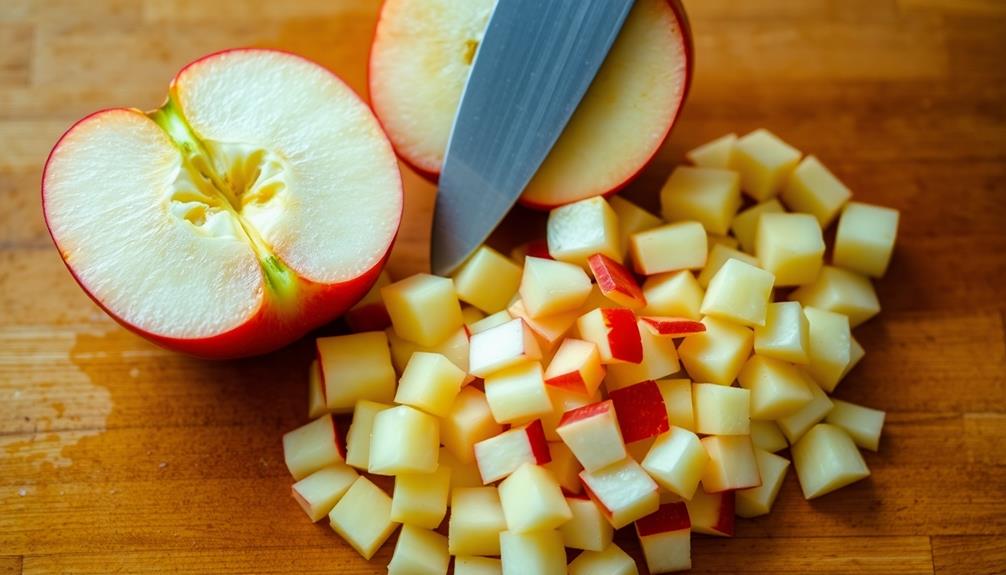
First, peel the apples using a sharp knife or vegetable peeler. Be careful as you work, watching your fingers. Remove the skin in long, smooth strokes, revealing the crisp, white flesh underneath.
Next, place the peeled apples on a cutting board. Using a sharp chef's knife, slice the apples in half from top to bottom. Scoop out the core and seeds with a small spoon or paring knife. Discard the cores.
Now, dice the apple halves into small, bite-sized pieces. Make even, uniform cuts, roughly 1/2 inch in size. This will help the apples cook evenly and blend nicely in the salad.
As you dice, try to work quickly to prevent the apples from browning. Place the diced pieces in a bowl, ready to be combined with the other Waldorf salad ingredients.
With the apples prepped, you're one step closer to enjoying this delicious and refreshing dish.
Step 2. Add Chopped Celery
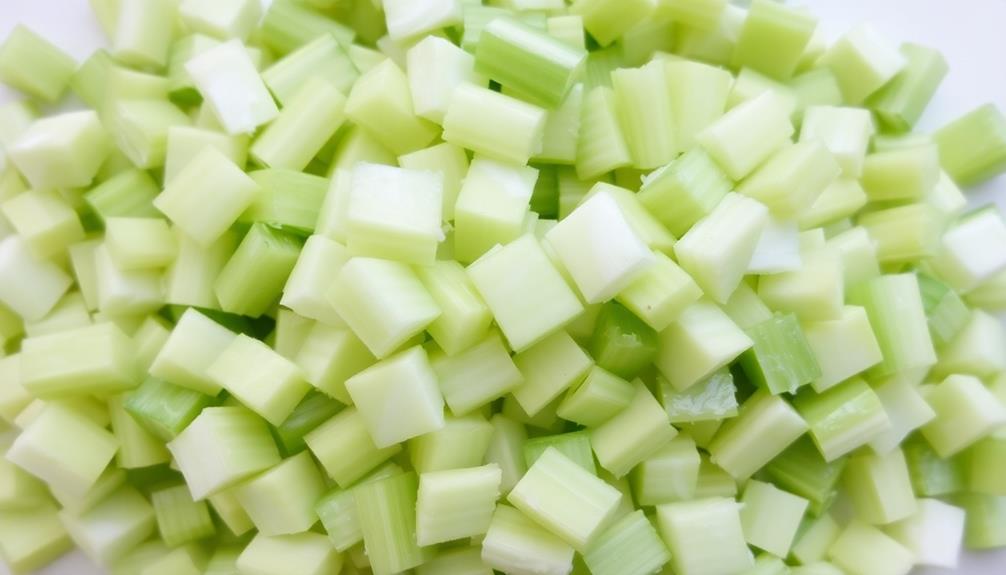
Next, grab a few crisp stalks of celery from your refrigerator. Wash them thoroughly under cool running water, then use a sharp knife to chop the celery into small, bite-sized pieces.
Be careful to keep your fingers safe as you work. The crunchy celery will add a wonderful texture and flavor to your Waldorf salad. As you chop, notice the satisfying sound of the knife slicing through the celery. The fresh, slightly herbal aroma will fill your kitchen, getting you even more excited to mix everything together. Once the celery has been chopped, it will be ready to join the rest of the ingredients in the bowl. Along with the celery, be sure to add the crisp, juicy apples and the toasted walnuts for a delightful contrast in textures. After you’ve mixed everything together, take a moment to savor the aroma of the salad before moving on to preparing the delicious zucchini pizza bites.
Once you have the celery chopped, add it to the bowl with the diced apples. Gently stir the ingredients to combine them evenly. The bright green celery pieces will create a lovely contrast against the golden apples.
With the celery now incorporated, your Waldorf salad is really starting to come together. Next, you'll need to add the remaining ingredients to complete this classic dish.
Step 3. Fold in Mayonnaise and Lemon Juice
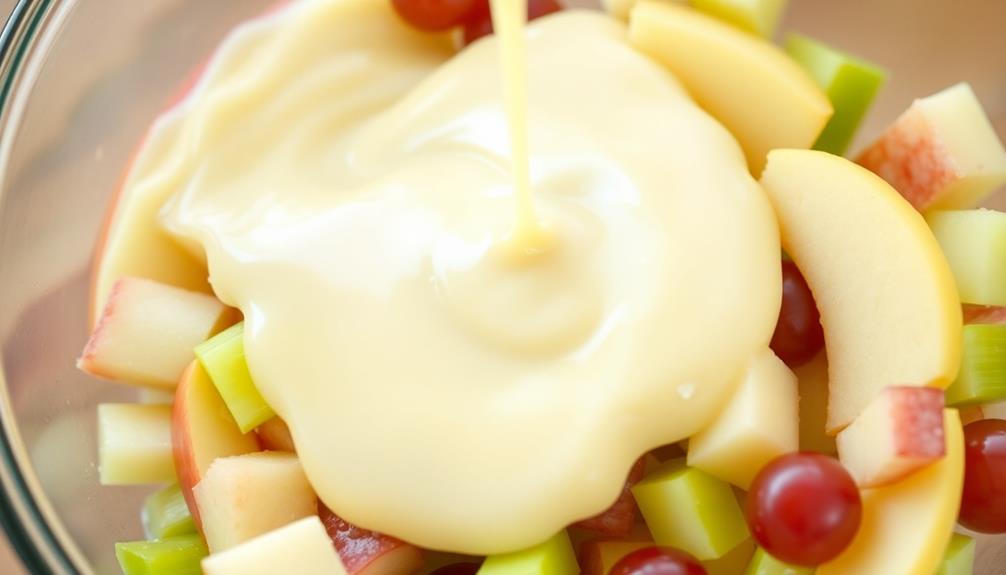
With the crunchy celery now incorporated, it's time to add the creamy and tangy components to your Waldorf salad. In a large bowl, gently fold in a few spoonfuls of mayonnaise.
Start with a small amount and gradually increase until the salad is lightly coated, being careful not to overdo it. The mayonnaise will help bind the ingredients together and create a delightful, smooth texture.
Next, squeeze in a bit of fresh lemon juice. The bright, citrusy notes will balance the richness of the mayonnaise and complement the sweetness of the apples and grapes.
Stir everything together until the lemon juice is evenly distributed. Taste as you go, adjusting the amounts of mayonnaise and lemon to suit your personal preferences.
The key is to find the perfect balance of creaminess, tang, and freshness that will make your Waldorf salad truly irresistible.
Step 4. Sprinkle With Crushed Walnuts
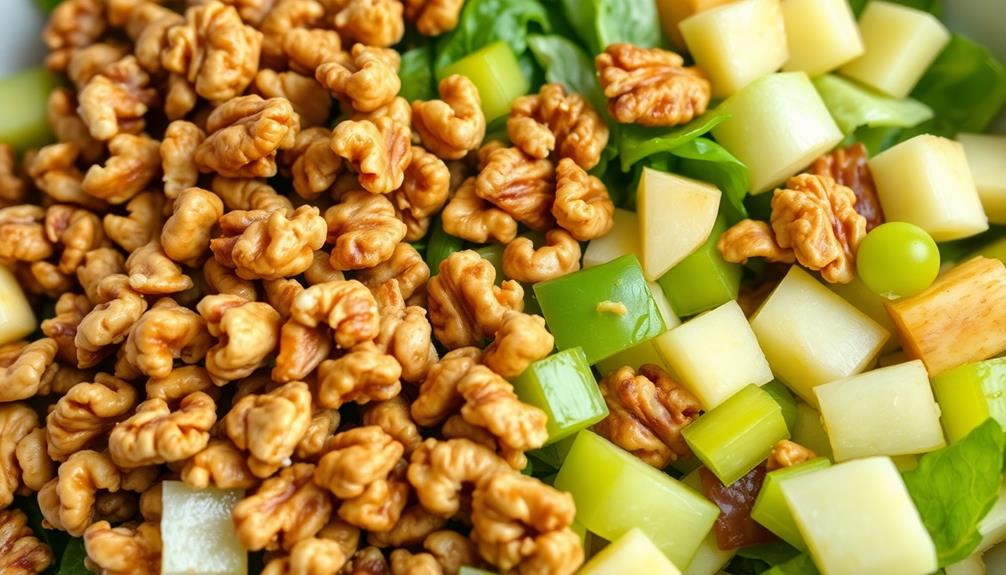
A handful of crushed walnuts will add a lovely crunch and earthy flavor to your Waldorf salad. Sprinkle the walnuts generously over the top, making sure they're evenly distributed. You'll love how their toasted notes complement the sweetness of the apples and grapes.
Incorporating nuts like walnuts not only enhances the flavor but also adds nutritional value, similar to how essential oils can enhance mood and relaxation.
The walnuts don't just provide texture, though. They're also packed with healthy fats, protein, and vitamins. With each bite, you'll be getting a nutritional boost along with that delightful crunch.
Just be careful not to overdo it – a little goes a long way when it comes to these flavorful nuts.
Once you've sprinkled the walnuts, your Waldorf salad is ready to serve. The combination of crisp apples, juicy grapes, and the nutty crunch of the walnuts creates a truly irresistible dish.
Get ready to wow your family and friends with this classic, yet elevated, salad.
Step 5. Chill Salad Before Serving
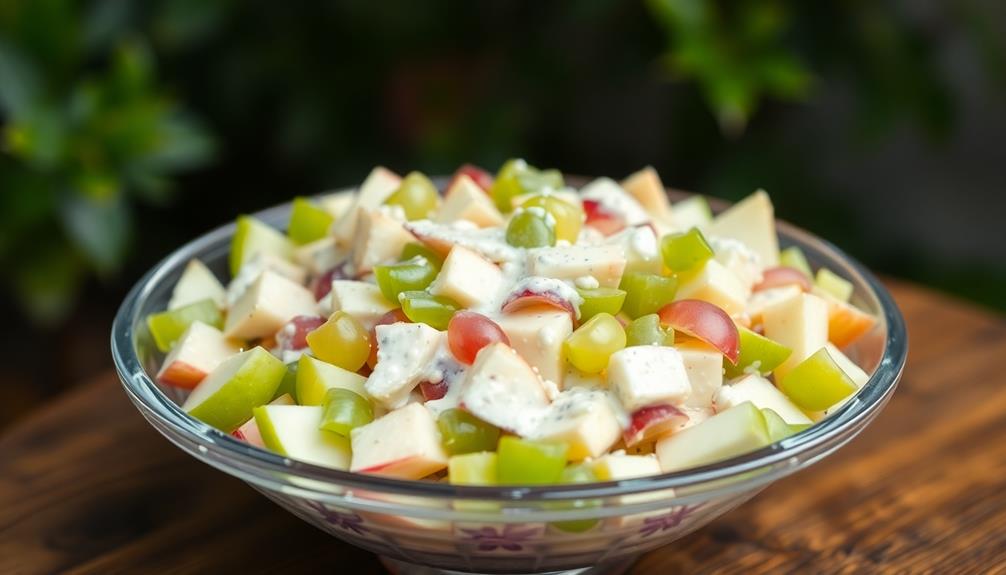
After sprinkling the crunchy walnuts over the Waldorf salad, it's time to chill the dish before serving. This step is crucial to ensure the flavors meld together and the ingredients are nice and cold. Once the Waldorf salad is properly chilled, the sweet and juicy strawberries will provide a refreshing burst of flavor with each bite. The cold temperature will also enhance the crispness of the apples and celery, making for a delightful and satisfying dish. Taking the time to chill the salad allows for a more enjoyable dining experience, as the flavors will be perfectly balanced and the textures will be at their peak.
Grab your serving bowl and pop it in the fridge for about 30 minutes. This chilling process will make the apples, celery, and grapes extra crisp and refreshing.
Once the salad has had a chance to chill, you're ready to enjoy! Carefully remove the bowl from the fridge and take a whiff – the aromas of the fresh ingredients will have intensified.
Give the salad a gentle stir to evenly distribute the creamy dressing. Then, scoop generous portions onto plates or into bowls. Your guests will love the burst of flavor and satisfying crunch in every bite.
Chilling the Waldorf salad is the perfect finishing touch before serving up this classic, crowd-pleasing dish.
Final Thoughts
Waldorf salad is a classic dish that continues to delight taste buds. Whether you're serving it as a side or enjoying it as a main course, this flavorful salad is a crowd-pleaser. The combination of crisp apples, crunchy celery, and tangy mayonnaise creates a harmonious blend of textures and flavors.
While the chilling process is essential, the final touches bring the salad to life. Don't be afraid to experiment with additional ingredients like grapes, walnuts, or even a sprinkle of lemon juice to enhance the flavors. To really take your winter fruit salad to the next level, consider incorporating a mix of seasonal fruits such as pomegranate seeds, clementines, and diced apples. The combination of these fruits adds a pop of vibrant color and a sweet and tangy flavor that will make your salad stand out. For a show-stopping winter fruit salad recipe, try garnishing with fresh mint leaves and a drizzle of honey for a deliciously refreshing finish.
The beauty of Waldorf salad lies in its versatility – you can customize it to suit your personal preferences. As you savor each bite, let the flavors transport you to a cozy gathering or a summer picnic.
Waldorf salad is a timeless classic that will continue to delight for generations to come. Embrace the simplicity and enjoy the delightful experience it offers.
Frequently Asked Questions
What Is the Difference Between Waldorf Salad and Regular Fruit Salad?
The main difference between a Waldorf salad and a regular fruit salad is the addition of nuts, typically walnuts, and a creamy dressing, usually mayonnaise-based. Waldorf salad has a richer, creamier texture compared to a lighter, more refreshing fruit salad.
Can Waldorf Salad Be Made Ahead of Time?
You can make Waldorf salad ahead of time, but it's best to wait to add the apples and dressing until just before serving. This prevents the salad from getting soggy or discolored. The ingredients can be prepped and stored separately for easy assembly.
How Long Does Waldorf Salad Typically Last in the Refrigerator?
Typically, Waldorf salad can last 3-4 days in the refrigerator when stored properly in an airtight container. However, it's best to consume it within 2-3 days for the freshest flavor and crispest texture.
Can Waldorf Salad Be Frozen for Later Use?
You can freeze Waldorf salad, but the texture and crispness of the apples and celery may suffer. It's best to consume the salad within 3-5 days of making it for optimal freshness and flavor.
Is Waldorf Salad a Healthy Option for a Side Dish?
Yes, Waldorf salad can be a healthy side dish option. It's packed with fresh fruits, nuts, and a light dressing, providing a nutritious balance of flavors and textures to complement your main meal.
Conclusion
You'll love how the crisp apples, crunchy walnuts, and creamy dressing come together in this classic Waldorf salad. It's a delightful blend of flavors and textures that'll have you dreaming of summer picnics. Plus, it's super easy to whip up, so you can enjoy this tasty treat anytime. Go on, give it a try – your taste buds won't be disappointed!



